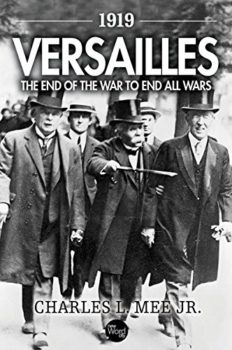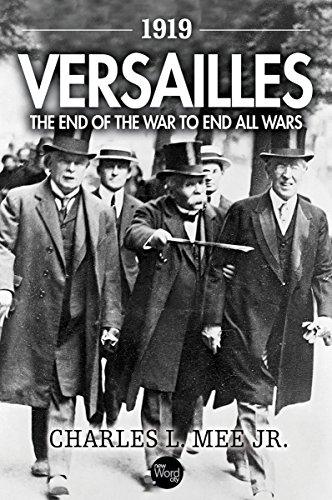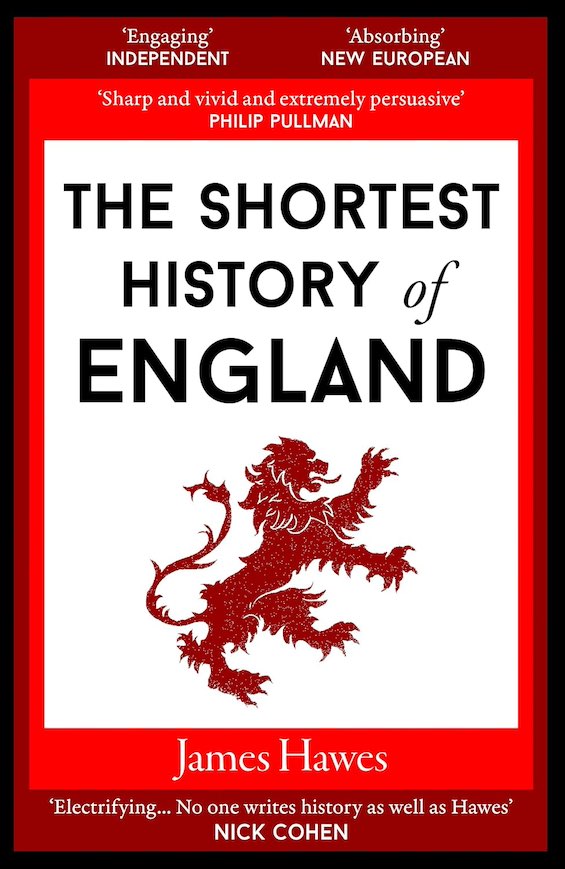
The cover of this remarkable book pictures the three principals who negotiated the Versailles Treaty ending World War I: David Lloyd George of England, Georges Clemenceau of France, and Woodrow Wilson of the United States. They’re all smiling. But when the treaty was eventually signed seven months after the Armistice that ended the fighting, they weren’t smiling any longer. The travesty these three men imposed on an unsuspecting world led inexorably to the rise of Hitler and Mussolini and the even worse carnage of World War II. And in 1919 Versailles, playwright and historian Charles Mee expertly lays bare the double-dealing, manipulation, and sheer vindictiveness that produced this tragic set of consequences.
A tight focus on the men who wrote the World War I peace treaty
Scores of books have been written about the Treaty of Versailles and its aftermath. The legendary economist John Maynard Keynes, who was a junior member of the British delegation, savaged the agreement soon after its signing. His The Economic Consequences of the Peace, published just months after the Treaty was signed, was a worldwide bestseller. For years afterward, the topic was a favorite of academics. And still today the books keep coming. But none that I’ve come across dig so deeply into the personalities and interpersonal conflicts of the men who wrote the treaty as well as Mee’s 1919 Versailles.
Read this remarkable book, and you’ll understand how things could go so badly wrong.
1919 Versailles: The End of the War to End All Wars by Charles L. Mee, Jr. (2014) 480 pages ★★★★★
Three arrogant, manipulative, and egotistical men led the way
All three of the principals (George, Clemenceau, Wilson) were arrogant, manipulative, and egotistical. They came to deeply distrust one another. And none of the three listened more than rarely to advice from the hundreds of advisors who accompanied them to Paris (where the negotiations actually took place). Both George and Wilson were flagrant adulterers. And Clemenceau was openly vindictive. It was he who dominated the discussions as the peace conference chair. He was a rude, nasty man, and he was primarily responsible for the draconian provisions of the treaty. The picture Mee paints of him suggests he may well have been a sociopath.
All three men, too, were products of the 19th century. Clemenceau had been born in 1841, Wilson in 1856, and George in 1863. The youngest of them was thus 37 at the turn of the 2oth century. With attitudes and opinions formed in another era, perhaps it’s not so surprising that they failed to understand the dynamics and the needs of the societies they governed.
Woodrow Wilson could have dominated the conference
Woodrow Wilson had famously attempted to set the agenda for the peace conference with his Fourteen Points. If he had demonstrated even a hint of the skill that had gotten him elected President of the United States he might well have upstaged Clemenceau and dominated the conference. At the outset of the negotiations he was wildly popular throughout Europe. It was to him that the Germans went to press for peace, and the understanding they reached with him was that the Fourteen Points would be the basis for a peace settlement. If Wilson had gone over the heads of Georges Clemenceau and David Lloyd George and spoken to the European public, he might well have pushed the French and English into a corner from which there was no escape.
Instead, however, Wilson sat meekly through the sessions, deferring to Clemenceau at almost every opportunity. He sacrificed every advantage in favor of pressing for the incorporation of the Covenant of the League of Nations into the final settlement. And that, of course, proved to be pointless, since he proved unable even to persuade the US Senate to approve the agreement.
Nobody read the treaty until it was too late
Many history books gloss over the sheer complexity of the challenge that the peace conference confronted. In addition to the principal combatants—Germany, France, Britain, Austria-Hungary, Russia, Italy, and the US—dozens of other nations became involved. After all, this was the First World War. And the conference had been convened to rationalize those interests, a clearly impossible task. In fact, as the arguments heated up in Paris, the most controversial questions were frequently farmed out to “commissions” that were empowered to draw up proposed solutions. In most cases, the commissions came back at the last minute with extreme proposals they fully expected the principals to moderate. But instead their proposals were incorporated into the draft treaty. Nobody read the treaty before it was printed. Nobody. And the principals stoutly refused to make any changes once the Germans protested the clearly unreasonable terms.
The scales were tipped against Germany
As Mee notes, “All of the most extreme provisions that Allies had contemplated seemed to have made their way into the finished treaty . . . In every instance, it seems, the scales had been tipped against Germany: the treaty was a work of malice.”
In fact, many participants in the conference as well as the Germans (who were not invited to participate) had fully expected that the conference would offer a set of proposals to which the German government could then make counterproposals. But that was not to be. The principals decreed otherwise. In the end, Clemenceau, George, and Wilson effectively told the Germans to accept the treaty as written or face an invasion of their homeland.
Mee’s concluding assessment of the treaty’s effects are savage. “[F]ar from restoring order to the world,” he writes, “they took the chaos of the Great War, and, through vengefulness and inadvertence, impotence and design, they sealed it as the permanent condition of our century.”
For related reading
I’ve also reviewed Adam Hochschild’s excellent book about the domestic opposition to World War I in the combatant nations: To End All Wars: A Story of Loyalty and Rebellion, 1914-1918. My review is at World War I: Learning history the hard way.
And for an account of the war’s origins, and the fighting that ensued, see The First World War by John Keegan (They called it the Great War, and so it was).
You might also be interested in:
- 10 top nonfiction books about World War II
- 20 top nonfiction books about history
- 10 great biographies
And you can always find my most popular reviews, and the most recent ones, on the Home Page.


























